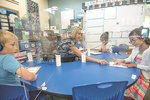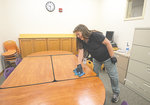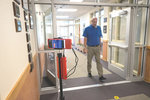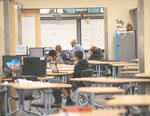Cloudy, 36° F
Soon after parents snap their traditional first-day-of-school photos, kids will put on face coverings, walk through temperature scanners and slather on hand sanitizer.
This is back to school in …
This item is available in full to subscribers.
The Powell Tribune has expanded its online content. To continue reading, you will need to either log in to your subscriber account, or purchase a subscription.
If you are a current print subscriber, you can set up a free web account by clicking here.
If you already have a web account, but need to reset it, you can do so by clicking here.
If you would like to purchase a subscription click here.
Please log in to continue |
|





Soon after parents snap their traditional first-day-of-school photos, kids will put on face coverings, walk through temperature scanners and slather on hand sanitizer.
This is back to school in 2020.
On Tuesday, Aug. 25, schools in Powell and Clark will reopen to students under a new plan requiring various health and safety measures amid the COVID-19 pandemic.
“Most staff members that I’ve spoken to are so excited to get kids back in classrooms,” said Jay Curtis, superintendent of Park County School District No. 1. “We’re just not complete unless we have kids roaming the halls.”
Of the feedback he’s received from parents, staff and the community about reopening Powell schools, Curtis said 98% has been positive.
“There has been the 2% of people who are upset that we are making students wear face coverings,” he said, but “by and large, many of those people have expressed their desire to have their kids back in school [and that] outweighs their hatred of the face coverings.”
The school district is providing cloth neck gaiters for all students, which “will serve as a face covering when social distancing is not achievable,” according to the reopening plan.
The district is not requiring students to wear masks at all times. For instance, face coverings will not be required during P.E. activities.
Plexiglass partitions will be used in some classrooms, especially kindergarten through second grade.
“We don’t think it’s realistic or practicable to think that an elementary kid is going to wear a mask or a gaiter or any other kind of face covering for seven hours straight,” Curtis said. “So utilizing those physical barriers of plexiglass will allow them to take mask breaks and still be reasonably socially close to their peers, which is an important part of their development; they need that interaction.”
Kids and teachers in Title I and a new Reading Recovery program also will utilize partitions, as it’s important to see each other’s mouths as kids learn to read.
Keeping schools open
The district’s reopening plan outlines three tiers to respond to varying levels of COVID-19 activity and restrictions. The hope is to operate under Tier I, where all schools are open, and avoid shutdowns under Tier III, similar to what happened in the spring.
“I don’t know that anybody, except for a very select few, wants to go back to what we had to go through this spring,” Curtis said.
When asked how many cases would prompt closing schools, Curtis said “there’s really not a metric on that.”
“Having a few positive cases in our building is not going to necessitate a shutdown,” he said, adding, “I think a spike is definitely different than a couple of cases.”
The district will take its cues from public health officials, Curtis said, and contact tracing is an important tool.
“Just because one kid in the classroom comes down with COVID-19 does not mean that every kid in the classroom is going to be quarantined,” Curtis said. “It’ll have to be determined, like who is at their table, who is in close contact.”
District leaders learned a lot about contact tracing during summer school, since a staff member was in close contact with a person who tested positive for COVID-19.
If there’s a spike in cases at one school, the district is discussing whether that building could close under Tier III while other schools remain open in Tier I or II.
“We’re just gonna have to be fluid,” Curtis said.
Park 1 has developed “a really great” relationship with Park County Health Officer Dr. Aaron Billin, and “he’s been a phenomenal resource to us,” Curtis said.
To keep schools open, the superintendent said everyone needs to be diligent and work together in following health and safety measures.
That starts with screening kids at home for any symptoms of COVID-19, such as cough, sore throat, new loss of taste or smell, fever or shortness of breath.
“There’s going to be a level of responsibility for them at home, doing home screens before they ever decide to put their kid on the bus or put them in the car and bring them to school,” Curtis said.
Schools to follow multiple safety measures
Mealtime modifications
Breakfast and lunch will continue to be served, but self-serve options will be eliminated, unless an item is prepackaged.
Parents will not be allowed to bring snacks for holiday parties or birthdays unless the items are prepackaged and individually wrapped.
Students will eat in cafeterias, but must wear masks or gaiters while in line, unless social distancing can be maintained.
“Students will have to be masked on their way into the cafeteria until they get to their seat, where they have the plexiglass barriers,” said Jay Curtis, superintendent of Park County School District No. 1.
After removing their face coverings to eat, kids will have to put them on to take their trays back. Current health orders limit more than 50 people in a room unless certain measures are in place, such as masks or barriers.
Staggered schedules at some schools will mean fewer kids eat together in the cafeteria.
At the middle school and high school, additional spaces will be used for mealtimes, such as the gymnasium, so kids will be more spread out.
For Powell High School students, open campus will remain for lunchtime.
“If we closed campus, that doesn’t mean that those same kids aren’t riding to school together and driving home together,” Curtis said.
But students will be encouraged to follow health guidelines.
“We are going to very heavily try to educate our students at the high school to not violate health orders when they’re not with us,” the superintendent said. “Because the main goal is that obviously we want to get kids in classrooms but then we have to do the work to keep them there.”
All cafeterias will be cleaned and sanitized at or above state and federal guidelines.
Bus changes
Face coverings will be required on school buses or other district vehicles.
Students will be required to sit one per seat on the bus when possible, unless they live in the same household. An alternative is to assign students a daily seat partner, to minimize exposure risk.
“Ensuring students remain physically distanced on school buses is a significant challenge,” the reopening plan says.
To minimize cross contamination, buses will take students to school and home, without having to change buses.
The district is encouraging parents to provide transportation for children if possible.
Temperature scans
All students, staff and visitors will have their temperatures scanned when entering a school building, including for athletic events. If a person has an elevated temperature, a school nurse or another staff member will do a manual scan.
“And if they’re still hot, then we put a mask on them and send them to an isolation room for 10 minutes to see if their temperature normalizes,” Curtis said. “If it’s still over 100 degrees, then they’ll have to be picked up. They’ll be provided a sheet of return-to-school guidelines that parents have to follow.”
Curtis said schools recognize that lots of different ailments can cause a fever — and research shows a large percentage of children with COVID-19 may not have a temperature — but there will be a heightened sense of awareness.
“It’s not the best metric, but my feeling is, we want everything available to us,” Curtis said. “Because even if we just catch one kid, that’s gonna help us keep our schools open.”
Visitor restrictions
Visits will be restricted to only essential visitors, such as those making a delivery, and they will be required to wear masks.
“We’re not gonna be able to allow parents to come in and have lunch with their children,” Curtis said. “This breaks my heart, but we probably are not going to be able to allow volunteers in our buildings for now.”
There will be designated drop-off spots for items in the front office.
“If a parent comes and wants their child, they’ll wait at the front office and we’ll have a staff member go bring them to the front,” Curtis said. “... we won’t be able to allow very many people to be walking in and out of the schools.”
Drinking fountains
Most drinking fountains are being retrofitted with touch-free bottle fillers.
“Their primary use will be to fill water bottles,” the plan says. “We recommend that all students bring water bottles to school so that they can refill them at a drinking fountain or sink.”
Students are reminded to never share water bottles.
Handwashing, cleaning and disinfecting
While hand-sanitizing stations will be available in schools, “we will promote handwashing over hand sanitizer to the greatest extent we can, because it’s better,” Curtis said, adding, “We will be diligent in making sure that students are keeping their hands clean.”
Schools underwent deep cleaning ahead of the new year, and staff will work hard to keep buildings and buses clean.
“We’ll be cleaning high-touch surfaces multiple times throughout the day,” he said.
Beyond custodians, teachers and other staff will be provided materials to regularly sanitize desks and high-touch surfaces, such as light switches, phones and doorknobs.
A copy of the reopening plan can be found online at www.pcsd1.org.